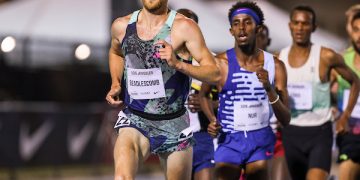 Tracy Sundlun, by Dillon Vibes
Tracy Sundlun, by Dillon Vibes
Tracy Sundlun is an honorable man, a bit eccentric, but an honorable man. He has not seen an endurance event, from the marathon to the 50k Race Walk that he does not support. Romaine Soh captures his love of one of the most iconic events in the Olympic tradition. This is Romaine’s first piece for RunBlogRun. We thank Lori Shontz, Romaine’s professor of Track & Field Journalism, at the University of Oregon, for her support and assistance fo these fine young journalists.
By Romaine Soh
SALEM, Oregon — Even with the sun shining relentlessly upon the steps of the Oregon State Capitol, some athletes and coaches were still milling around nearly two hours after the 20-kilometer race walks at the U.S. Olympic Track and Field Trials had concluded Thursday morning. Some were catching up with each other. Others were coming up to race director Tracy Sundlun to thank him for putting on such a great event.
The race walks were the only events held outside of the main festivities at Hayward Field in Eugene. Despite a last-minute change that saw the event starting an hour and a half earlier than planned, spectators still lined the majority of the course, something the competitors greatly appreciated.
“This is the biggest crowd ever for race-walking,” men’s champion John Nunn told the crowd.
Sundlun, a 2015 inductee into the Running USA Hall of Fame, is best known lately as co-founder of the Rock & Roll marathon series. Working with race walking, however, was dramatically different.
For the marathons, Sundlun has to convince people to take part. On the other hand, the race walkers are dying to compete, which presents him with a different challenge of bringing the sport to fans to increase awareness. During the 1987 IAAF World Race Walking Cup Championship in New York’s Central Park, Sundlun said he had trouble persuading people to volunteer. However, when people saw the Russians, East Germans and Chinese training in Central Park, their attitude changed.
Said Sundlun, “They saw the race-walkers passing all these runners, looking beautiful, and went, ‘That’s race-walking? Oh my God.’ All of a sudden, word got out, and it was packed.”
For the Olympic Trials, the priority was to showcase the event, with the initial end time right around lunch hour to attract workers in downtown Salem, including employees at the Capitol. But the organizers believed that performance trumped presentation, and started the walkers off earlier to protect them from the projected heat later in the day.
A 1-kilometer loop, located a block away from the Capitol building, comprised most of the race route. Spectators could walk freely along the course to find their favorite spot to cheer for the walkers. Walkers started and ended their Olympic bid in front of the Capitol building, a strategic gesture by the trials’ local organizing committee, Tracktown USA, to show their thanks to the people of Salem and those in the legislature for supporting their efforts to bring international events to the state of Oregon.
“This place is beautiful,” Sundlun said. “We had to finish here because of the ‘gold guy,'” he added, gesturing to the Oregon Pioneer statue sitting atop the Capitol.
Ian Whatley, who finished 14th, was full of praise for the new location and the commentary that Sundlun provided throughout the event.
“The 1-kilometer loop is short, so you get a lot of interchange in between the people in the crowd,” said Whatley.
He said that at the previous trials, spectators struggled to get into the stadium to watch the event. This time, people were invited to watch the walkers. “You wave to the kids, they went wild,” Whatley said.
That’s what Sundlun wanted to hear.
“In the end, the key is how people react,” said Sundlun. “I could be pleased as punch, but if the athletes weren’t, it didn’t work.”
The race-walking community is aware that they aren’t always on the radar. Carmen Jackinsky, a race walking coach in Portland, has observed that when people talk about the events at the Olympic trials, they talk about everything except race-walking. The event tends to be held outside the stadium since the sheer number of turns the walkers have to make on the track is not desirable.
Women’s champion Maria Michta-Coffey took the microphone from Sundlun after he announced the first two finishers to credit the New York public high school system for introducing her to race-walking. She and runner-up Miranda Melville, the only two women who met the Olympic standard, were products of that system.
“When you have the race-walk in the high school system, Olympians are possible,” said Michta-Coffey, a 30-time national champion.
The community recognizes that exposure is the most important aspect to be more noticeable. USATF hosted a kids race-walk clinic the day before, which saw a turnout of 400 kids ranging from 4 years old to high schoolers. On race day, kids and cheerleaders from North and West Salem who participated in the “Adopt a walker” program were scattered all over the course cheering on the walkers. Colored shirts with the favorites’ names printed in bold on the back, such as “Team Nunn,” were part of the festivities.
“The people of Salem seemed to be receptive of what was happening,” said Jackinsky. “They weren’t talking down about it — they were really excited. That’s a good thing.”
Sundlun, a three-time director of the 50K race walk trials, is a pioneer in aggressively promoting the race walk, and he continues to pave his way as a visionary for the sport.
“Nobody else did it,” he said, explaining why he got involved with race walkers. “They are good guys. It’s a legitimate Olympic sport.”





















